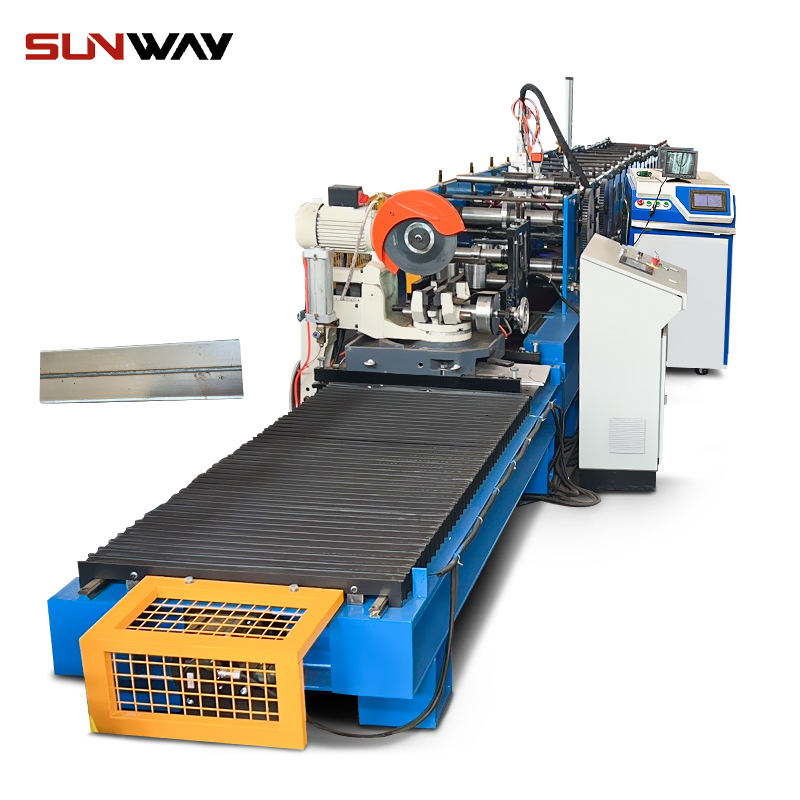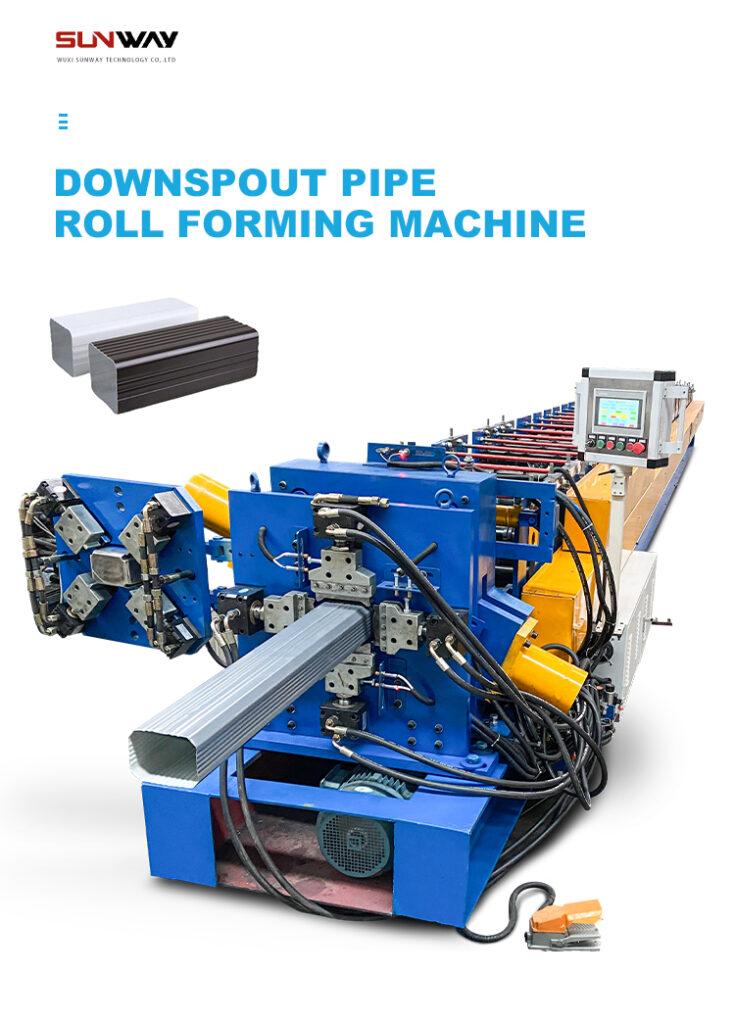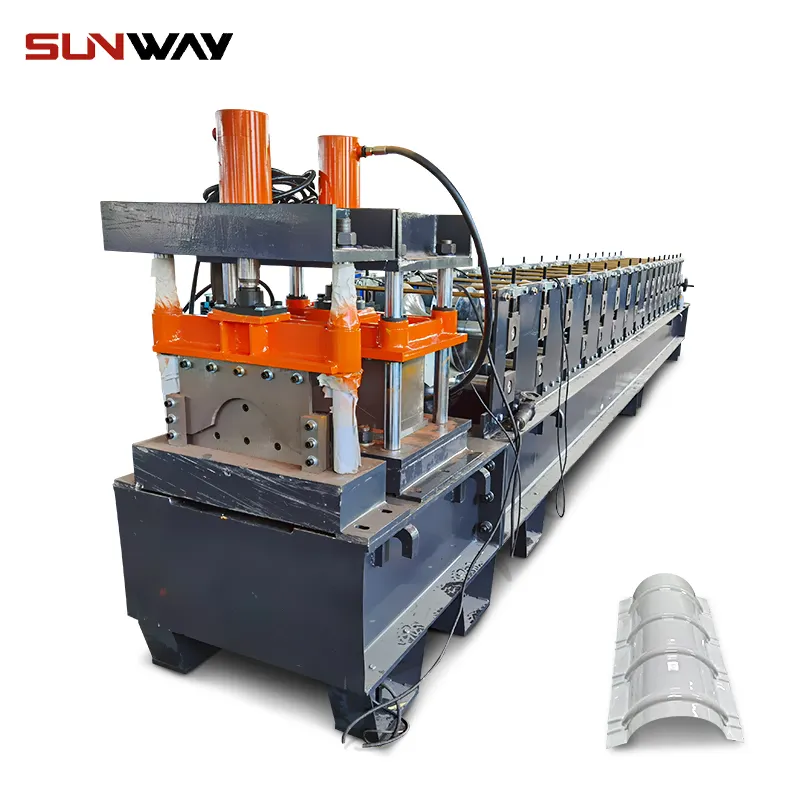ماكينات التشكيل بالدلفنة تُستخدم لثني وتشكيل اللفائف المعدنية إلى مقاطع جانبية مخصصة من خلال سلسلة من حوامل التشكيل التدريجي بالدلفنة. يمكن لهذه التقنية متعددة الاستخدامات إنشاء مقاطع عرضية معقدة ودقيقة لمختلف التطبيقات في صناعات مثل البناء والنقل والبنية التحتية وغيرها.
سيغطي هذا الدليل الشامل جميع جوانب ماكينات ما بعد التشكيل بالدلفنة من الأنواع ومبادئ العمل والمكونات والمواصفات والتطبيقات والمزايا والقيود. ويتضمن جداول مفصلة وأسئلة شائعة للمساعدة في مقارنة الخيارات المختلفة واتخاذ قرار مستنير لاحتياجاتك في التشكيل بالدلفنة.
نظرة عامة على ماكينات التشكيل بالدرفلة
التشكيل بالدلفنة اللاحقة هي عملية تشكيل معدنية مستمرة ومتعددة الاستخدامات تقوم بتحويل الشرائط أو الملفات المعدنية المسطحة إلى مقاطع جانبية مخصصة. وهي تعمل عن طريق ثني المواد تدريجياً من خلال سلسلة من حوامل اللفائف مرتبة في خط. يقوم كل حامل بعمل ثني تدريجي صغير حتى يتم الوصول إلى المظهر الجانبي النهائي للمقطع العرضي.
الملامح الرئيسية لتشكيل ما بعد الدرفلة:
- إنشاء ملفات تعريف مقطعية طويلة ومعقدة ودقيقة للمقاطع العرضية
- عملية مؤتمتة وفعالة للغاية مع معدلات إنتاج سريعة
- القدرة على تشكيل مواد عالية القوة مثل الفولاذ المقاوم للصدأ والألومنيوم
- انخفاض تكاليف الأدوات مقارنة بطرق التصنيع الأخرى
- الحد الأدنى من إهدار المواد حيث تتم المعالجة على مخزون اللفائف
- التغييرات في الملامح التي يتم إنجازها عن طريق تغيير أدوات اللف
- متكامل مع عمليات مثل التثقيب، والقطع، واللحام للأجزاء النهائية
أنواع ماكينات التشكيل بالدرفلة
| نوع الماكينة | الوصف |
|---|---|
| ماكينات النشر الثابتة | أدوات اللف مثبتة على حوامل لفات فردية بالتتابع لتشكيل المظهر الجانبي بشكل تدريجي |
| ماكينات البريد المتحرك | حوامل البكرات قابلة للحركة لضبط مراحل التشكيل حسب التشكيل الجانبي |
| ماكينات لف القفص | تجمع بين ميزات ماكينات العمود الثابتة والمتحركة لتحقيق المرونة |
| خطوط التشكيل بالدرفلة عالية السرعة | إنتاج مقاطع جانبية بسرعات تزيد عن 100 متر/دقيقة عن طريق تداخل محطات البكرات |
المكونات الرئيسية لماكينة التشكيل بالدلفنة العمودية
| المكوّن | الوظيفة |
|---|---|
| آلة التفكيك | تغذية شريط اللفائف المعدنية في حوامل التشكيل بالدلفنة |
| لفائف العلف | تسحب المواد إلى قسم التشكيل بسرعة محددة |
| لفات التشكيل | ثني المواد تدريجيًا من خلال سلسلة من الحوامل |
| لفائف القرص | دعم وتوجيه الشريط من خلال محطات البكرات |
| محطة القص | تقطيع الملامح إلى الأطوال المرغوبة |
| مكدس | يجمع الملامح المقطوعة |
| لوحة التحكم | يتحكم في السرعة، ويوجه التعديلات والمراقبة |

تطبيقات ماكينات التشكيل بالدرفلة
يُستخدم التشكيل بالدلفنة لتصنيع المقاطع المعدنية في مجموعة واسعة من الصناعات:
الإنشاءات والبنية التحتية
- الأسقف (درزات قائمة، تثبيت مخفي)
- ألواح الكسوة
- تلبيسة الجسر
- ملامح الصرف
- الأقسام الهيكلية
- أنظمة الدرابزين
- منتجات الطرق السريعة
- المدادات والدعامات
السيارات والنقل
- مكونات الشاسيه
- هياكل الشاحنات
- إطارات هيكل الحافلة
- تسقيف عربات السكك الحديدية
- كواتم الصوت وكاتمات الصوت
- لوحات السيارات
المعدات والأجهزة
- قوائمُ الحامل
- العبوات الكهربائية
- تركيبات الإضاءة
- أقسام الرفوف
- أقسام النوافذ
- أثاث مكتبي
- أواني الطهي والأواني
مزايا التشكيل بالدرفلة اللاحقة
- عملية متعددة الاستخدامات للغاية وقادرة على تشكيلات معقدة ومركبة
- جودة متناسقة وتفاوت في الملامح
- إنتاج سريع مع إنتاجية عالية للمواد
- القدرة على تشكيل الفولاذ عالي وعالي القوة للغاية
- انخفاض الاستثمار في الأدوات مقارنة بالعمليات الأخرى
- الحد الأدنى من الخردة المفقودة حيث يتم تشكيل اللفائف تدريجياً
- استخدام طاقة أقل من التصنيع الآلي أو الكبس
- تبديل سريع للبكرة باستخدام أدوات معيارية
- معدات مدمجة تتطلب مساحة أقل من عمليات تصنيع المعادن الأخرى
اعتبارات الشراء لماكينات التشكيل بالدلفنة العمودية
العوامل الرئيسية التي يجب مراعاتها عند الاستثمار في ماكينة التشكيل بالدلفنة:
مواصفات الملف الشخصي المطلوب
- شكل المنتج وتعقيد المقطع العرضي
- سُمك المعدن ودرجة المادة
- دقة الأبعاد والتفاوتات في الأبعاد
- معدل الإنتاج أو الناتج المطلوب
- نطاق عرض مادة اللفائف المراد تشكيلها
متطلبات كفاءة الإنتاج
- مستوى الأتمتة المطلوب
- التكامل مع العمليات الأخرى مثل التثقيب أو التقطيع
- تبديل سريع بين الملفات الشخصية
- ميزات مراقبة وتحكم مدمجة
قيود المساحة والتخطيط
- الطول الإجمالي بناءً على عدد حوامل التشكيل
- متطلبات التغذية الداخلية والخارجية
- ارتفاع الخط وارتفاع الرأس
- التكامل مع العمليات الحالية
اعتبارات الميزانية والتكلفة
- السعر الأساسي للماكينة بالإضافة إلى المعدات الإضافية
- الشحن والتركيب والتشغيل التجريبي
- تدريب المشغلين وموظفي الصيانة
- مستوى خدمة ما بعد البيع والدعم الفني المطلوب
سيضمن لك التقييم الصحيح للعوامل المذكورة أعلاه اختيار حل التشكيل بالدلفنة المثالي المصمم خصيصًا لتلبية احتياجات الإنتاج الخاصة بك.
مواصفات ماكينات التشكيل بالدرفلة
يتم تخصيص خطوط ما بعد التشكيل بالدلفنة بمكونات يتم اختيارها بناءً على متطلبات التطبيق. فيما يلي نظرة عامة على مواصفات الماكينة النموذجية:
إطار ولفائف
- تصميم الإطار: إطار على شكل حرف C أو إطار على شكل O
- كمية محطة التدحرج: من 10 إلى 26 عادةً
- مادة الدرفلة: D2، سبيكة فولاذ D2، سبائك الصلب، أداميت
- قطر البكرة: 100 إلى 250 مم
- تعديل التدحرج: يدوي أو بمساعدة الطاقة
- مصدر طاقة البكرة: محرك سيرفو كهربائي أو محرك هيدروليكي
معلمات المواد
- نوع المادة: الفولاذ الطري، الفولاذ المقاوم للصدأ، الألومنيوم
- سُمك المادة: 0.5 إلى 3 مم عادةً
- عرض المادة: نطاق المواد: 300 إلى 1250 مم
- تعريف الملف: من 400 إلى 610 مم قياسي
السرعة والإنتاج
- سرعة التشكيل: من 10 إلى 120 م/دقيقة
- نطاق طول القطع: 1 إلى 10 م
- معدل الإنتاج: حتى 8000 متر/ساعة
معايير التصميم والهندسة
يجب أن يتوافق تصميم ماكينات التشكيل بالدلفنة والمكونات وميزات السلامة مع المعايير الوطنية والدولية. وتشمل المعايير الرئيسية ما يلي:
- ISO 12100 - سلامة الآلات - ISO 12100 - سلامة الآلات
- EN 1010 - متطلبات السلامة للماكينات
- ISO 841 - ISO 841 - الروبوتات الصناعية وأنظمة الروبوتات
- ISO 5348 - ماكينات التشكيل بالدرفلة
- لوائح حراسة الماكينات الخاصة بإدارة السلامة والصحة المهنية
يقوم المصنعون ذوو السمعة الطيبة ببناء آلات تلبي أحدث المعايير أو تتجاوزها. يضمن الامتثال السلامة التشغيلية وجودة الإنتاج المقبولة عالميًا.
تركيب وتشغيل ماكينات التشكيل بالدلفنة العمودية
تعتبر إجراءات التركيب والتشغيل السليمة ضرورية للتشكيل بالدلفنة الآمن والفعال والعالي الجودة:
إرشادات التثبيت
- تأكد من وجود مساحة كافية لطول الماكينة، والتغذية الداخلية والخارجية للمواد
- سطح أرض مستوٍ لمنع مشاكل الاهتزاز
- تم تجهيز التأريض المناسب وخطوط إمداد الطاقة
- أدوات الدرفلة وحراس السلامة والأجهزة المركبة
- تمت محاذاة جميع المحطات ومعايرتها واختبارها
قائمة مراجعة العمليات
- اختيار مادة الملف المناسب وتحميلها
- تمرير الشريط عبر البكرات وفي آلية التغذية
- ضبط المعلمات مثل سرعة الخط، وطول القص
- بدء عملية التشكيل واختبار قطع العينة
- مراقبة تغذية الشريط، وضبط البكرة، وجودة القطع
- إجراء الصيانة الدورية بين عمليات الإنتاج
احتياطات السلامة
- ضمان التدريب المناسب للموظفين على تشغيل الماكينة
- معدات الوقاية الشخصية الإلزامية مثل الملابس الضيقة ونظارات السلامة
- لا تصل أبدًا إلى مناطق التشغيل أو الحراس المفتوحة
- أوقف التشغيل في حالة اكتشاف خطأ في تغذية شريط الملف أو انحشاره
- اتبع إجراءات الإغلاق للصيانة والصيانة

صيانة ماكينات التشكيل بالدرفلة
تعمل الصيانة الدورية على تحسين وقت التشغيل والإنتاجية والسلامة بشكل كبير. وتشمل الجوانب الرئيسية ما يلي:
يومياً:
- الفحص البصري لأدوات البكرة، ومحاذاة الشريط، وجودة القطع
- تحقق من عدم وجود مثبتات مفكوكة أو اهتزاز أو ضوضاء غير طبيعية
- إزالة الحطام المعدني والغبار المتراكم
أسبوعيًا:
- تشحيم المحامل وأعمدة الدوران
- فحص السلاسل والأسنان المسننة والتروس
- افحص مستويات السوائل الهيدروليكية
- اختبار أجهزة إيقاف الطوارئ والسلامة في حالات الطوارئ
شهرياً:
- تنظيف شامل لجميع المحطات
- افحص الأعمدة والمحامل وموانع التسرب بحثًا عن التآكل
- افحص الأسلاك والتوصيلات الكهربائية
- معايرة/تعديل المكونات والبكرات إذا لزم الأمر
سنويًا:
- الفحص الكامل للإطار، والبكرات، والمحركات
- استبدل المكونات البالية مثل المحامل وموانع التسرب
- قم بترقية أجزاء الماكينة أو البرامج إذا لزم الأمر
ستؤدي الصيانة المناسبة وفقًا للجدول الزمني المذكور أعلاه وإرشادات دليل الماكينة إلى زيادة عمر ماكينة التشكيل بالدلفنة وأدائها إلى أقصى حد ممكن.
اختيار الشركة المصنعة لماكينة تشكيل العمود
يعد اختيار الشركة المصنعة المناسبة أمرًا حاسمًا للحصول على ماكينة تشكيل بالدلفنة عالية الأداء تناسب احتياجاتك:
معايير التقييم الرئيسية
- سنوات من الخبرة في معدات التشكيل بالدرفلة
- مجموعة متنوعة من الملامح القادرة على إنتاج
- استخدام مواد ومكونات عالية الجودة
- مستوى التخصيص المتوفر
- ابتكار التصميم والميزات المتقدمة
- الامتثال لمعايير السلامة
- دعم فني سريع الاستجابة قبل البيع
- التركيب الاحترافي وتدريب المشغلين
- القدرة على الصيانة والخدمة
- توافر قطع الغيار على المدى الطويل
- أسعار تنافسية وضمان المنتج
سيساعدك إجراء العناية الواجبة عبر المعايير المذكورة أعلاه على تحديد أفضل شريك في تشكيل اللفائف لتلبية متطلبات الإنتاج والنجاح على المدى الطويل.
تحليل تكلفة ماكينات التشكيل بالدرفلة اللاحقة
تعتمد تكلفة ماكينة التشكيل بالدلفنة على عوامل مثل:
- حجم الإطار وسعته
- عدد محطات التشكيل بالدلفنة
- مستوى الأتمتة والميزات الإضافية
- مواد البناء
- سرعة الإنتاج والإنتاجية
- العلامة التجارية للشركة المصنعة وموقعها
النطاق السعري النموذجي:
| سعة الماكينة | نطاق السعر |
|---|---|
| الخطوط اليدوية وشبه الآلية | $40,000 إلى $60,000 |
| خطوط التشكيل بالدلفنة متوسطة التحمل | $60,000 إلى $150,000 |
| خطوط عالية السرعة وأوتوماتيكية | $150,000 إلى $500,000 |
| خطوط الخدمة الشاقة للمواد عالية القوة | من $500,000 إلى $2,000,000 |
تضيف المعدات الإضافية مثل آلات فك اللفائف، والمقصات، والمكدسات $20,000 إلى $60,000 عادةً.
التركيب والشحن والتدريب يمكن أن تكلف 15-25% إضافية حسب الموقع والنطاق.
عقود خدمة ما بعد البيع حوالي 5-101 تيرابايت 3 تيرابايت من تكلفة الماكينة سنويًا.
من المفهوم أن اختيار خطوط مؤتمتة ذات سعة أعلى من العلامات التجارية المتميزة يكلف أكثر مقارنةً بحلول التشكيل بالدلفنة الأساسية. ولكن زيادة الاستثمار تؤتي ثمارها من خلال زيادة الإنتاج والكفاءة والدقة وانخفاض تكاليف التشغيل.

إيجابيات وسلبيات ماكينات التشكيل بالدرفلة اللاحقة
المزايا
- عملية مرنة للغاية وقادرة على عمل أشكال جانبية معقدة
- جودة متناسقة مع تفاوت متقارب في الأبعاد
- سرعات وأحجام إنتاج عالية
- انخفاض تكلفة الأدوات مقارنة بالعمليات الأخرى
- تغيير سريع في التشكيل الجانبي باستخدام أدوات معيارية
- بصمة مدمجة توفر مساحة المصنع
- يمكن تشكيل مجموعة واسعة من المواد بما في ذلك الفولاذ المتقدم عالي القوة
- انخفاض الفاقد من الخردة حيث يتم تشكيل اللفائف تدريجياً
- يعمل الإنتاج الآلي على تحسين السلامة وتقليل العمالة
القيود
- الاستثمار الأولي للماكينة أعلى بالنسبة للخطوط المؤتمتة
- يزداد تعقيد التصميم لبعض الملامح الغريبة
- ليست مثالية لإنتاج الدفعات الصغيرة أو النماذج الأولية
- يتطلب تصميم البكرات الخبرة والتجربة
- الصيانة الدورية اللازمة للحفاظ على الأداء
- قدرة محدودة على تشكيل الملامح المتماثلة
في حين أن التشكيل بالدرفلة اللاحقة له بعض العيوب، فإن فوائده العديدة تجعله عملية تصنيع قيّمة مناسبة لعمليات الإنتاج الطويلة للأجزاء المعدنية في العديد من الصناعات.
التعليمات
س: ما هي المواد التي يمكن تشكيلها بعد اللف؟
يمكن أن تنتج ماكينات التشكيل بالدلفنة اللاحقة التشكيلات الجانبية من:
- فولاذ منخفض الكربون
- فولاذ عالي القوة
- الفولاذ المقاوم للصدأ
- ألومنيوم
- النحاس
- نحاس
يتراوح النطاق من 0.3 مم إلى 4 مم للمعادن ذات الليونة الجيدة.
س: ما هي التفاوتات التي يمكن تحقيقها؟
يمكن أن يحقق التشكيل بالدلفنة القياسي:
- تفاوت طول المظهر الجانبي ± 1 مم
- تفاوت طول القطع ± 2 مم
- تفاوت القوس ± 1 مم لكل 1000 مم طول
مع الأدوات والماكينات عالية الدقة، يمكن الحصول على تفاوتات تفاوتات تصل إلى ± 0.5 مم.
سؤال: ما مدى سرعة تغيير الملفات الشخصية؟
يعتمد وقت التغيير على مدى تعقيد خط تشكيل اللفائف:
- الماكينات الأساسية من 1 إلى 2 ساعة
- أنظمة التغيير السريع: 30 دقيقة إلى 1 ساعة
- خطوط مؤتمتة بالكامل: من 15 إلى 30 دقيقة
لذا فإن الاستثمار في الأدوات المعيارية سريعة التغيير يقلل من التأخير في التبديل.
س: ما الذي يؤثر على سعر ماكينات التشكيل بالدرفلة؟
العوامل الرئيسية المؤثرة في التكلفة:
- سرعة الإنتاج ومتطلبات الإنتاج
- مستوى الأتمتة
- ميزات متقدمة مثل التبديل السريع
- سُمك المواد الخام وقوتها
- الدقة ومستويات التحمل
- سمعة الشركة المصنعة
من المفهوم أن الخطوط ذات السعة الأعلى والأسرع والأوتوماتيكية تكلف أكثر.
س: ما هي جوانب السلامة التي يجب أخذها في الاعتبار؟
تتضمن ميزات السلامة الحرجة ما يلي:
- الحراس والحواجز المادية المتشابكة
- أزرار إيقاف الطوارئ في متناول اليد
- أضواء التحذير والإنذارات والمؤشرات المرئية
- مستشعرات للكشف عن الانحشار أو عدم المحاذاة
- امتثال المعدات لمعايير السلامة
- تدريب الموظفين على الإجراءات المناسبة
وهذا يقلل من المخاطر المحتملة في عملية التشكيل بالدلفنة.
س: ما هي التشكيلات الملفوفة الشائعة؟
تشمل الأشكال الشائعة المنتجة ما يلي:
- قنوات C و U
- أقسام "زيد" و"سيجما
- زوايا وملامح L
- ألواح ذات أضلاع وتمويجات
- المقاطع الأنبوبية الصندوقية والمستطيلة
- مقاطع الأنابيب المنحنية والمستديرة
- أقسام خاصة مثل حواجز حماية الطرق السريعة
إمكانيات الملف الشخصي لا حصر لها بناءً على احتياجات تصميم المنتج الخاص بك.
س: كيف يمكن تقليل تكاليف أدوات الدرفلة إلى الحد الأدنى؟
استراتيجيات لتقليل نفقات الأدوات:
- توحيد الملفات الشخصية للاستخدامات المتعددة إن أمكن
- اختر ماكينات العمود المتحرك لإعادة استخدام بعض الحوامل
- استخدام الأدوات المعيارية التي تسمح بإعادة ترتيب أجزاء اللفافة
- تخزين الأدوات بشكل صحيح لإعادة استخدامها في الطلبات المستقبلية
- العمل مع مورد الأدوات لتحسين التصميم
- بناء خبرة داخلية في مجال تصنيع الأدوات من أجل تصنيع فعال من حيث التكلفة
تساعد الطرق المذكورة أعلاه على خفض الاستثمار الإجمالي في الأدوات.
استنتاج
التشكيل بالدلفنة اللاحقة هي طريقة متعددة الاستخدامات ودقيقة ومنتجة لتشكيل المقاطع المعدنية بشكل مستمر من اللفائف. وهي توفر مزايا كبيرة لعمليات الإنتاج الطويلة عبر تطبيقات متنوعة.
يغطي هذا الدليل جميع الجوانب بدءًا من مبدأ العمل وأنواع الماكينات والمكونات الرئيسية والمواصفات والتطبيقات والفوائد والتكاليف وغير ذلك. ويقدم نظرة عامة مفصلة عن عملية التشكيل بالدلفنة باستخدام جداول لمقارنة العوامل المختلفة. يتم تقديم اعتبارات حاسمة للمساعدة في اختيار معدات ما بعد التشكيل بالدلفنة المثالية وفقًا لاحتياجات التصنيع والميزانية الخاصة بك.


